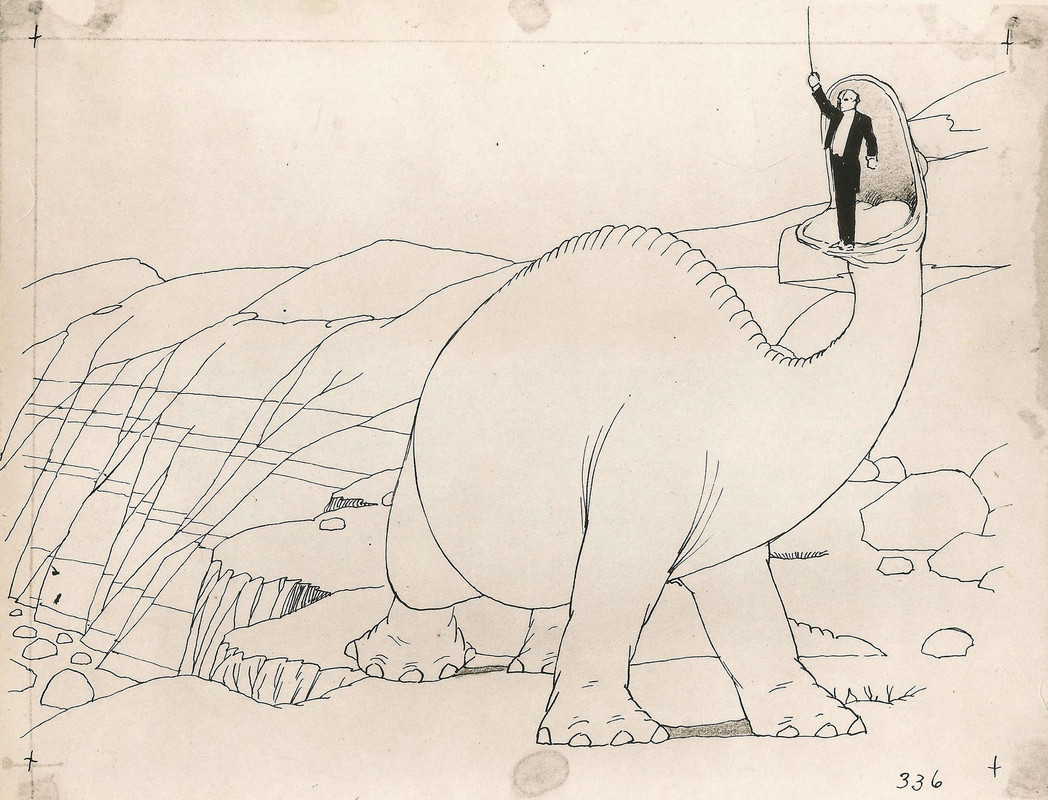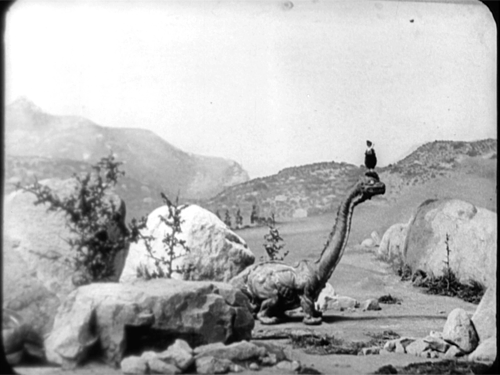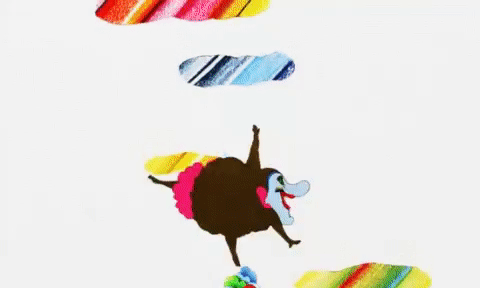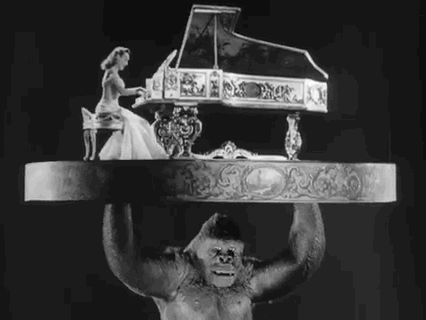viewGertie the Dinosaur (1914)
Gertie raises her creator Winsor McCay in her mouth. McCay holds a dressage whip but in his tuxedo resembles a musical conductor more than a lion tamer. DPs: John A. Fitzsimmons & Winsor McCay.

Gertie the Dinosaur (Winsor McCay, 1914)
I made ten thousand cartoons —each one a little bit different from the one preceding it.
Long before we all flocked to the movies, there was vaudeville. Vaudeville comes in many flavours, from raucous song and dance, acrobatics (see #BusterKeaton's start) to chalk talk: a live performance in which an artist would chat and draw on a blackboard in real time. The format is perfect to enlighten and entertain an audience, about the dangers of alcohol, the importance of religion, the demand for women's suffrage.
But where there's a scholar, there's a showman. As a chalk talk consists of a succession of quickly drawn illustrations, one flowing into the next while the performer raps over it, the leap to animation is a logical one. In 1914, a brontosaurus named Gertie and a comic strip creator called Winsor McCay travelled the land – both animated and real.
McCay, known for his fantastic comic strips Little Nemo in Slumberland and its predecessor Dream of the Rarebit Fiend, introduced the great animated animal to the audience with little tidbits of knowledge about the mighty brontosaurus, throw her an apple, demonstrate her gentleness by stepping into the screen (a parlour trick made the transition from real to animated look incredibly convincing) and let Gertie carry him around in her prehistoric world. In front of the delighted audience, the showman then would reappear into our realm.
The movies were young and promising, and Gertie's leap to celluloid was made the very same year. Gertie the Dinosaur (1914), an adaptation of the vaudeville act and the first animated dinosaur movie, moves the stage to a dinner party at the animator's studio, where McCay shows off his animation skills as part of a bet.
Gertie, with its combination of animated and real content, had a huge influence on film makers to come. You can see it in Max Fleischer's wonderful Out of the Inkwell cartoons (1918 – 1929) and Ubi Iwerk's Alice Comedies (1923 – 1927, the only original work that ever came out of the Disney studios). And Buster Keaton? In honour of Gertie he rode a claymation brontosaurus in his Three Ages (1923).
The Boy's (Buster Keaton) nifty use of a pre-Willis O’Brien stop-motion Brontosaurus' high vantage point. DPs: Elgin Lessley & William C. McGann.

#Bales2023FilmChallenge #WinsorMcCay #JohnAFitzsimmons #vaudeville #comedy #dinosaurs #animals #animation #ShortFilm #SilentFilm #USA #1910s
#todo
view
Sinong lumikha ng yoyo? Sinong lumikha ng moon buggy? [Who Invented the Yoyo? Who Invented the Moon Buggy?] (Kidlat Tahimik, 1979)
May
30
National Creativity Day
Kidlat Tahimik test driving his moon buggy, closely followed by faithful crew member Gottlieb (Kidlat Gottlieb Kalayaan). DP: Kidlat Tahimik.
“If you don't eat too many Gummy Bears you could be my co-pilot.”
– Kidlat Tahimik, speaking to a budding crew member
Sinong lumikha ng yoyo? is a remarkable display of imaginative filmmaking. Together with Kidlat we ponder about practicalities, suddenly see connections that were obscured by too much thinking, and realise all the new possibilities we have in life. Part documentary, part animation, part fantasy, part sci-fi, Kidlat transports us to yet unexplored spaces!
view
You the Better (Ericka Beckman, 1983)
May
8
VE-Day
One of the players, an handsome young white man, celebrates a score. He wears blue pants with a yellow string, a blue shirt with a blue T-shirt underneath. On his head a red and white hat. The bill hides part of his face. He's got his right arm raised in victory. Behind him other players in identical kits. On the back of shirts a a symbol that looks like a surprised smiley, or a bowling ball.
“HANDS UP
PUT YOUR HANDS UP
GIMME MORE
GIMME GIMME MORE BETTER GIMME MORE”
– recurring chant
view
Yellow Submarine (George Dunning, 1968)
Apr
28
Clean Comedy Day
A Blue Meanie pirouetting on a blossoming flower that pushes itself up into the sky. The sky is white while the flower and clouds are multicoloured.
A Gen X-er, I grew up in a completely different world where so many films and TV that kids watched – if watched with today's eyes — were not particularly kid-oriented at all. I fondly remember Monty Python and the Holy Grail (1975) and reenacting the Black Knight scene in the school grounds. Yul Brynner as a faceless, rampaging cyber cowboy in Westworld (1973)? Sure, bring it on! Not that the official kid's movies were “clean”. Did you spot the chicken decapitation in Willy Wonka & the Chocolate Factory (1971)? Well, you will now.
“Once upon a time, or maybe twice, there was an unearthly paradise called Pepperland. 80,000 leagues beneath the sea it lay, or lie. I'm not too sure.”
– narrator
Alright, I'll keep it clean and suggest a dose of Yellow Submarine. A fantastic adventure starring The #Beatles (well, their likeness mostly) who are summoned to save utopian, music-loving #Pepperland from the music-hating Blue Meanies. Trippy fun, and lots to discover the older you get.
view
Mighty Joe Young (Ernest B. Schoedsack, 1949)
Apr
12
National Only Child Day
Jill playing the grand piano in a ballgown while suspended high up in the air by Joe. DP: J. Roy Hunt.
Young Jill – played by the tragically doomed Lora Lee Michel – grows up on a ranch in an undisclosed African country (aka “Africa”) with her father. One day, two porters pass her house carrying an orphaned baby #gorilla. Smitten, she wants and gets the ape, names it Joe, and raises it until the simian reaches exceptional size. That's when a couple of showman collecting exotic menagerie for a Hollywood nightclub come across the odd couple. After long consideration and desperate for money, Jill decides to take Joe to the States where the two become an overnight cabaret sensation. But like Kong before him, Joe is not made for the concrete jungle.
“Am I dreamin', or did I just see a gorilla? And a beautiful dame!”
– Max O'Hara
One decade and a Hays Code later, the people who brought the world King Kong (1933) present Mighty Joe Young: more drama, more spectacle, and superior special effects by Marcel Delgado, Ray #Harryhausen and Willis O'Brien et al. A box-office dud ánd Academy Award for Special Effects winner, Mighty Joe Young is now recognised as an #animation classic. In particular the nightclub scenes (keep your eyes peeled for Phil “The Swedish Angel” Olafsson!) are a wonderful display of the magic of #StopMotion.







